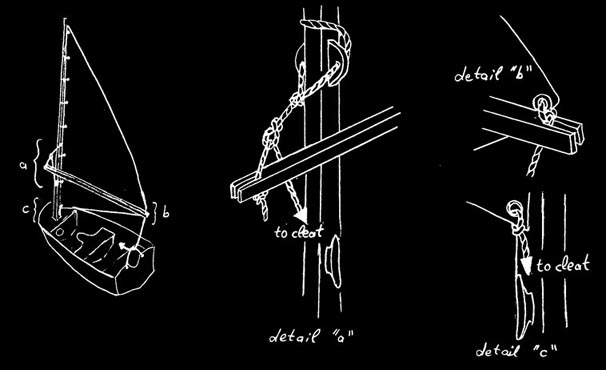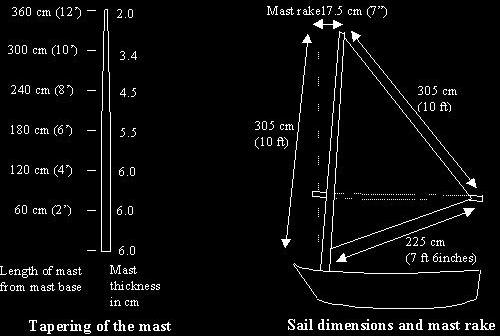
Details of the Rig
The plans of the D4, as downloaded from the Mertens-Goossens site, give two alternative rigs for the sailing version. One is a Marconi rig, and the other is a boomless sprit rig. I didn't want to mess with the gooseneck joint of the Marconi rig and don't like the boomless sprit although it has certain advantages such as low center of effort. I therefore decided to use a variation of the sprit rig in my D4 (loose footed sprit?). I got the idea from Dynamite Payson's book "Build the New Instant Boats". This rig and its details are shown below:

Detail "a" shows how the sprit boom is attached at its bow end, detail "b" shows how the clew of the sail is attached to the boom, and detail "c" shows how the tack of the sail is fastened to the mast. To fasten the head of the sail, drill a hole athwartships near the masthead and tie it there. I have laced the luff of the sail to the mast at every 60 cm (2 ft).
The mast is unstayed, which means it is not fixed in place by any shrouds or stays. The sail is permanently fastened to the mast and is not raised or lowered. When you are back from sailing, you roll up the sail and the sprit boom, tie everything with the mainsheet, pull the mast out and go home. The original plans carry 32 to 35 sq.ft. of sail. I recalculated sail dimensions to get a sail area close to 35 sq.ft. More importantly, I tried not to move the center of effort from the point given in the Marconi rig plan. Moving the center of effort from its designed location may be dangerous. You may get a lee helm which means the boat will move away from the wind if the tiller is not attended. This may result in accidental jibes.
I used a 360 cm (12 ft) long wooden mast. It is square with rounded edges. Dimensions are 6 cm by 6 cm at the mast base tapered to 2 cm to 2 cm at the top. The sprit boom is also square with rounded edges. It is 3.5 cm by 3.5 cm and 240 cm (8 ft) long. Dimensions of the mast and sail are given below.

Ordering a dacron sail for a boat of this size was out of question because I was not sure whether she would float and whether the rig would work even if she does. So I visited a local shop that makes tents, found a suitable canvas, and had it cut and sewn to my dimensions. Both the mast and the sail were heavy. The sail became heavier when wet, but, on the other hand, it was extremely sturdy. My conclusion is that an aluminum mast, a lighter (dacron?) sail and a Marconi rig would have been the most appropriate. But I must tell you that the wooden mast looks prettier.